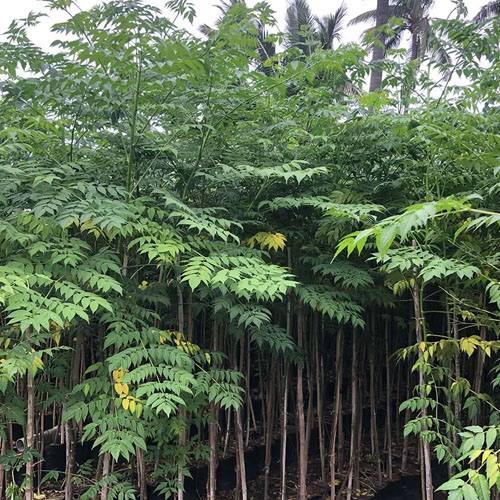Malabar Neem (Meeliya Dubiya) Plants
Malabar Neem, also known as Melia dubia (sometimes referred to as Melia azedarach or Melia composita), is a fast-growing deciduous tree native to Southeast Asia and parts of the Indian subcontinent. It is widely cultivated for its timber, which is used in plywood, furniture, and paper production, as well as for its medicinal properties. This tree is commonly called Malabar Neem in India and is known for its rapid growth and adaptability to a variety of soil and climatic conditions.
Key Features of Malabar Neem:
-
Appearance:
- Height: Malabar Neem can grow rapidly, reaching heights of 20 to 25 meters within 5 to 7 years under favorable conditions.
- Leaves: The leaves are large, up to 80 cm long, and bipinnate (twice-compound) with 20–30 pairs of leaflets. The leaflets are dark green, lanceolate, and have a smooth, glossy surface.
- Bark: The bark is grayish-brown, smooth in young trees, and becomes rough and fissured with age.
- Flowers and Fruits: The tree produces small, fragrant, white to pale purple flowers that grow in clusters. The fruit is a small, round drupe, initially green, turning yellowish-brown when ripe.
-
Growth Conditions:
- Climate: Malabar Neem thrives in tropical and subtropical climates with temperatures ranging from 20°C to 40°C. It can tolerate a wide range of rainfall, from 600 mm to 2,500 mm annually.
- Soil: The tree prefers well-drained sandy loam or red loam soils but can grow in a variety of soil types, including clayey and saline soils. It is moderately drought-tolerant and can withstand short periods of waterlogging.
-
Propagation:
- Seeds: Malabar Neem is typically propagated by seeds. Fresh seeds have a high germination rate, usually sown directly in nurseries. Seedlings are transplanted once they reach a height of about 30 cm.


